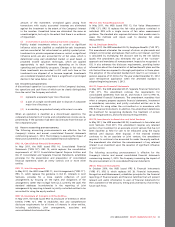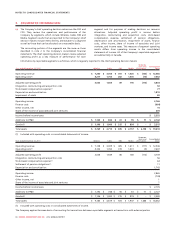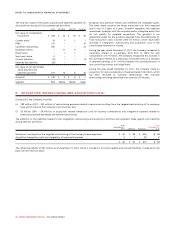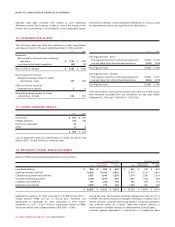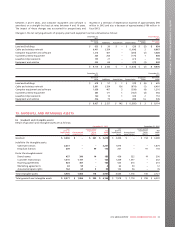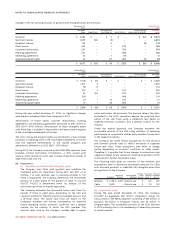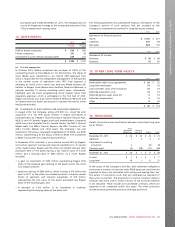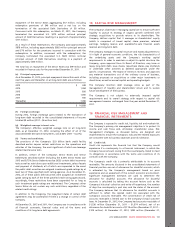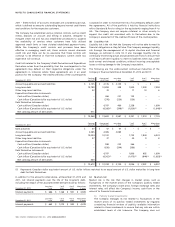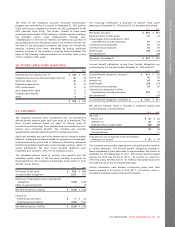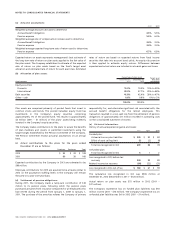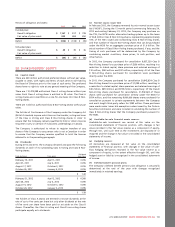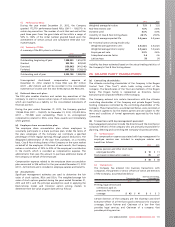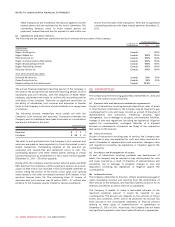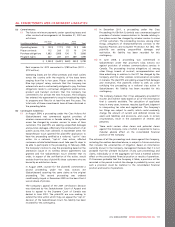Rogers 2012 Annual Report Download - page 107
Download and view the complete annual report
Please find page 107 of the 2012 Rogers annual report below. You can navigate through the pages in the report by either clicking on the pages listed below, or by using the keyword search tool below to find specific information within the annual report.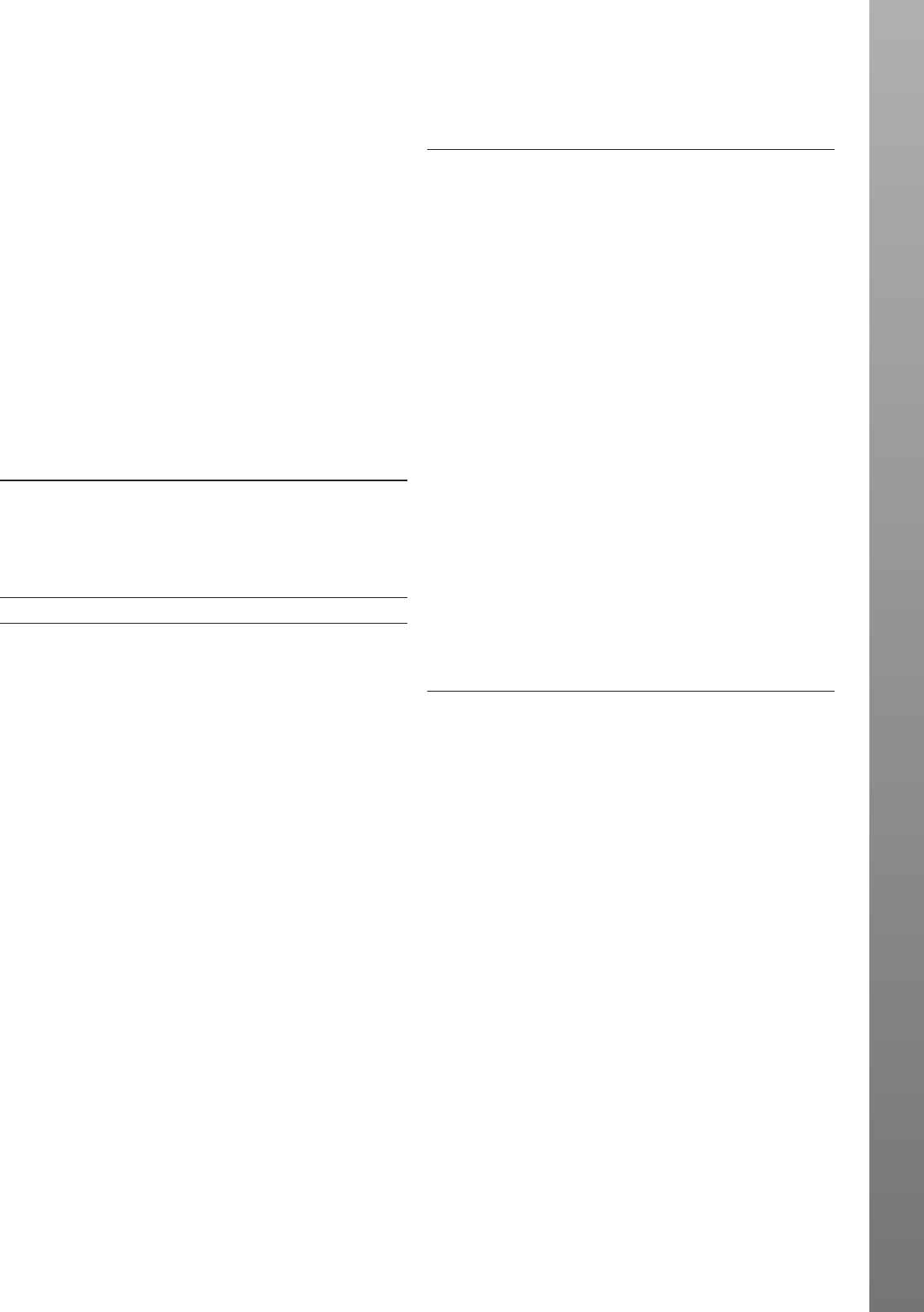
NOTES TO CONSOLIDATED FINANCIAL STATEMENTS
repayment of the Senior Notes aggregating $57 million, including
redemption premiums of $49 million and a net loss on the
termination of the associated Debt Derivatives of $8 million.
Concurrent with this redemption, on March 21, 2011, the Company
terminated the associated U.S. $470 million notional principal
amount of Debt Derivatives, resulting in a payment of approximately
$111 million.
As a result of these redemptions, the Company paid approximately
$878 million, including approximately $802 million principal amount
and $76 million for the premiums incurred in connection with the
redemptions. In addition, concurrent with the redemptions, the
Company terminated the associated U.S. $820 million notional
principal amount of Debt Derivatives, resulting in a payment of
approximately $330 million.
The total loss on repayment of the Senior Notes was $99 million and
recorded in finance costs for the year ended December 31, 2011.
(e) Principal repayments:
As at December 31, 2012, principal repayments due within each of the
next five years and thereafter on all long-term debt are as follows:
2013 $ 348
2014 1,094
2015 826
2016 1,000
2017 500
Thereafter 7,090
$ 10,858
(f) Foreign exchange:
During 2012, foreign exchange gains related to the translation of
long-term debt recorded in the consolidated statements of income
totalled $9 million (2011 – $6 million loss).
(g) Weighted average interest rate:
The Company’s effective weighted average rate on all long-term
debt, as at December 31, 2012, including the effect of all of the
associated Debt Derivative instruments, was 6.06% (2011 – 6.22%).
(h) Terms and conditions:
The provisions of the Company’s $2.0 billion bank credit facility
described earlier impose certain restrictions on the operations and
activities of the Company, the most significant of which are leverage
related maintenance tests.
In addition, certain of the Company’s Senior Notes and Senior
Debentures described earlier (including the 6.25% Senior Notes due
2013 and 8.75% Senior Debentures due 2032) contain debt incurrence
tests as well as restrictions upon additional investments, sales of assets
and payment of dividends, all of which are suspended in the event
the public debt securities are assigned investment grade ratings by at
least two of three specified credit rating agencies. As at December 31,
2012, all of these public debt securities were assigned an investment
grade rating by each of the three specified credit rating agencies and,
accordingly, these restrictions have been suspended for so long as
such investment grade ratings are maintained. The Company’s other
Senior Notes do not contain any such restrictions, regardless of the
related credit ratings.
In addition to the foregoing, the repayment dates of certain debt
agreements may be accelerated if there is a change in control of the
Company.
At December 31, 2012 and 2011, the Company was in compliance with
all financial covenants, financial ratios and all the terms and
conditions of its long-term debt agreements.
18. CAPITAL RISK MANAGEMENT:
The Company’s objectives in managing capital are to ensure sufficient
liquidity to pursue its strategy of organic growth combined with
strategic acquisitions to provide returns to its shareholders. The
Company defines capital that it manages as shareholders’ equity
(which is comprised of issued capital, share premium, retained
earnings, hedging reserve and available-for-sale financial assets
reserve) and long-term debt.
The Company manages its capital structure and makes adjustments to
it in light of general economic conditions, the risk characteristics of
the underlying assets and the Company’s working capital
requirements. In order to maintain or adjust its capital structure, the
Company, upon approval from its Board of Directors, may issue or
repay long-term debt, issue shares, repurchase shares, pay dividends
or undertake other activities as deemed appropriate under the
specific circumstances. The Board of Directors reviews and approves
any material transactions out of the ordinary course of business,
including proposals on acquisitions or other major investments or
divestitures, as well as annual capital and operating budgets.
The Company monitors debt leverage ratios as part of the
management of liquidity and shareholders’ return and to sustain
future development of the business.
The Company is not subject to externally imposed capital
requirements and its overall strategy with respect to capital risk
management remains unchanged from the year ended December 31,
2011.
19. FINANCIAL RISK MANAGEMENT AND
FINANCIAL INSTRUMENTS:
The Company is exposed to credit risk, liquidity risk and market risk.
The Company’s primary risk management objective is to protect its
income and cash flows and, ultimately, shareholder value. Risk
management strategies, as discussed below, are designed and
implemented to ensure the Company’s risks and the related exposures
are consistent with its business objectives and risk tolerance.
(a) Credit risk:
Credit risk represents the financial loss that the Company would
experience if a counterparty to a financial instrument, in which the
Company has an amount owing from the counterparty, failed to meet
its obligations in accordance with the terms and conditions of its
contracts with the Company.
The Company’s credit risk is primarily attributable to its accounts
receivable. The amounts disclosed in the consolidated statements of
financial position are net of allowances for doubtful accounts, which
is estimated by the Company’s management based on prior
experience and an assessment of the current economic environment.
Significant management estimates are used to determine the
allowance for doubtful accounts. The allowance for doubtful
accounts is calculated by taking into account factors such as the
Company’s historical collection and write-off experience, the number
of days the counterparty is past due, and the status of the account.
The Company believes that its allowance for doubtful accounts is
sufficient to reflect the related credit risk associated with the
Company’s accounts receivable. The concentration of credit risk of
accounts receivable is limited due to the Company’s broad customer
base. At December 31, 2012, the Company had accounts receivable of
$1,536 million (December 31, 2011 – $1,574 million), net of an
allowance for doubtful accounts of $119 million (December 31, 2011 –
$129 million). At December 31, 2012, $492 million (December 31,
2012 ANNUAL REPORT ROGERS COMMUNICATIONS INC. 103


